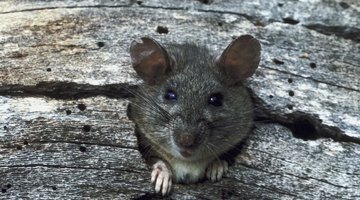I Have Rats in My Woodpile
Table of Contents
Woodpiles make a secure, comfortable home for all sorts of animals. Some of these animals, such as frogs, are useful in a garden. Others, especially rodents, may become a real nuisance.

With shelter in the form of a woodpile together with a plentiful food supply, perhaps from garbage cans or a bird table, rat populations can quickly explode.
Indications
Sightings of rats are the obvious sign; noting when and how often you see them gives you an indication of the population size. If you only occasionally see rats and only in the evenings or at night, there probably aren’t many. Regular sightings, especially during the day, suggest a more serious problem. Other signs you have rats in your woodpile include gnawed wood and droppings. Rat droppings are elongated ovals about 1/2 inch or longer. Significantly smaller droppings probably come from mice or voles.
Explanation
Rats take shelter in woodpiles for a variety of reasons. Woodpiles provide protection from the elements and a refuge from predators, forming a safe place for rats to sleep or raise their young. Woodpiles often contain a range of smaller animals, such as spiders and slugs, which are included in a rat's diet. The more undisturbed the woodpile, the more likely local rodents will set up home in it.
Problems
Rats aren’t going to ruin your wood if it is merely firewood. If the wood is for anything else, however, gnawing or soiling from rats could make it unusable. Large numbers of rats on your property cause other problems, eating vegetables, animal feed and fruits. If they venture inside your home, rats become a serious problem, causing damage and making a mess. They also may carry infections; handling any wood with your bare hands becomes a health risk.
Short-Term Solutions
If your woodpile is full of rats, always put on work gloves before removing wood. Aside from the infection risk, you run the risk of disturbing a rat and getting a nasty bite. Wash your hands thoroughly afterward. Rodent repellents, such as chili, commercial preparations, carnivore dung or peppermint oil, might deter rats in the short term. Also, stop feeding pets outside and put any food for wild birds in spill-proof feeders. Moving the woodpile as far away from your house as possible makes it less likely the rats will move inside. If you don’t want rats in your woodpile at all, you’ll need to move the wood to a rodent-proof outhouse, garage or shed.
Long-Term Solutions
Trapping is rarely effective in the long term, although a sustained effort might bring rat numbers down for a while. Rats breed rapidly and quickly learn to avoid new hazards such as traps. Encourage natural predators such as owls, mammalian carnivores and snakes. Rodent-proof your home to stop the rats causing serious problems inside. Block all gaps around pipes, windows and doors with the appropriate materials and place pantry food in glass, ceramic or metal containers. If you have fruit trees, fit animal guards around the trunks.
The Drip Cap
- Woodpiles make a secure, comfortable home for all sorts of animals.
- With shelter in the form of a woodpile together with a plentiful food supply, perhaps from garbage cans or a bird table, rat populations can quickly explode.
- Woodpiles provide protection from the elements and a refuge from predators, forming a safe place for rats to sleep or raise their young.
- They also may carry infections; handling any wood with your bare hands becomes a health risk.
- Wash your hands thoroughly afterward.
- Also, stop feeding pets outside and put any food for wild birds in spill-proof feeders.
- If you don’t want rats in your woodpile at all, you’ll need to move the wood to a rodent-proof outhouse, garage or shed.
Writer Bio
Judith Willson has been writing since 2009, specializing in environmental and scientific topics. She has written content for school websites and worked for a Glasgow newspaper. Willson has a Master of Arts in English from the University of Aberdeen, Scotland.
Photo Credits
- NA/AbleStock.com/Getty Images
- NA/AbleStock.com/Getty Images
More Articles



